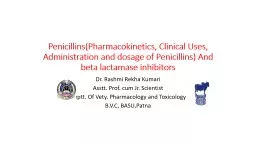

Penicillins And beta lactamase inhibitors Dr Rashmi Rekha Kumari Asstt Prof cum Jr Scientist Deptt Of Vety Pharmacology and Toxicology BVC BASUPatna Pharmacokinetics ID: 913054
Download Presentation The PPT/PDF document "Penicillins (Pharmacokinetics, Clinical ..." is the property of its rightful owner. Permission is granted to download and print the materials on this web site for personal, non-commercial use only, and to display it on your personal computer provided you do not modify the materials and that you retain all copyright notices contained in the materials. By downloading content from our website, you accept the terms of this agreement.
Slide1
Penicillins(Pharmacokinetics, Clinical Uses, Administration and dosage of Penicillins) And beta lactamase inhibitors
Dr. Rashmi Rekha KumariAsstt. Prof. cum Jr. ScientistDeptt. Of Vety. Pharmacology and ToxicologyB.V.C, BASU,Patna
Slide2PharmacokineticsPenicillin G, its salts and methicillin are destroyed by gastric acid and are orally ineffective. Only
the acid resistant penicilins like ampicillin, penicillin V, cloxacillin, oxacillin, amoxicillin can be given orally and their peak plasma concentration is reached within about two hours. Most of the penicillins including
repository penicillins are administered parenterally (usually IM).
Penicillins
are widely distributed in the body fluids and tissues. They can cross the blood brain barrier in sub therapeutic concentration in the presence of inflammation of meninges only.
Inflammation
also permits effective levels of certain
penicillins
in abscess and in pleural, peritoneal and synovial fluids. Their protein binding ranges from 20% (ampicillin) to 80 % (
cloxacillin
)
Slide3Penicillins are chiefly excreted through kidney (90%) unchanged in urine. Out of which 20% is by glomerular filtration and 80% by proximal tubular
secretionProximal tubular secretion of penicillin is inhibited by probenecid prolonging the effective blood level of penicillins. Some broad spectrum semisynthetic penicillins are also excreted through the bile.
Slide4Clinical uses of penicillinsThe
penicillins are used in the treatment of local and systemic infections caused by sensitive bacteria Penicillin G is of value in the treatment ofbovine mastitis (primarily in streptococcal mastitis ),
Anthrax,
Erysipelothrix
infection in sheep, pigs and
birds
S
trangles
in
horse,
clostridial
infections (tetanus and black quarter
),
pyelonephritis and lumpy jaw in cattle
,
beta-haemolytic streptococcal infection in puppies
,
Meningococcal
meningitis and
leptospirosis.
Slide5Administration and Dosages of penicillinsThe doses of penicillin G is usually expressed as units
One standard unit of penicillin is defined as the amount of antibacterial activity present in 0.6 µgm of pure crystalline standard sodium penicillin G (1mg=1667 Oxford unit).The dosage of semisynthetic penicillins is expressed in mg/kg. The Solution salt of benzyl penicillin is the most commonly used prepration for IM injection. When it is required for maintaining Sustained antibiotic levels in the body it is used as relatively less soluble organic salts such
as procaine benzyl penicillin or benzathine penicillin, such injections need to be repeated once in a day or two. The penicillin G preparations are
i
n
effective
when given by oral route due to inactivation by gastric acidity and intestinal flora.
Slide6Penicillin
Dosage(All Species)Route
Interval
Benzathine
penicillin G
10,000-40,000IU/kg
IM(Horse); SC (cattle)
48-72 hr.
Penicillin V
15,000 IU/kg
Oral
8 hr.
Sodium penicillin G
10,000-20,000IU/kg
IV or IM
6 hr.
Procaine penicillin G
25,000 IU/Kg
10,000-20,000 IU/KG
Oral
IM or SC
6 hr.
12-24 hr.
Ampicillin
5-10 mg/kg
10-25 mg/kg
IV,IM ,or SC
oral
8-12 hr.
6- 12 hr.
Amoxicillin
4-8mg/kg
12 mg/kg
IM
oral
12- 24 hr.
12 hr. (dog)
Cabenicillin
10-20 mg/kg
IV or IM
8-12 hr.
Cloxacillin
10 mg/kg
IM or Oral
6 hr.
Slide7Adverse Reaction and Toxicity of penicillin
Hypersensitive, allergic or anaphylactic reactions (mostly along with streptomycin) are reported in dog ,cattle and horse following prior sensitization to the antibiotic, T
he clinical signs noted were Salivation, Shivering,Vomition
and
U
rticaria
in cat and dog, laboured breathing ,salivation cutaneous oedema (head and
perinial
region) and froth from nostril and mouth in cattle and
urticaria
and
pruritis
in horse.
Slide8Beta-lactamasesAre enzyme produced by penicillin –resistant bacteria. Which break the antibiotic into inactive penicillioic
acid. They are named as beta-lactamases as the splitting the beta-lactam ring present in beta-lactam antibiotics, penicillins and cephalosporins
Some beta lactamase are specific for penicillins( penicillinase) and Some are specific for
cephalosporins
(
Cephalosporinase
) other have affinity for both.
Slide9Beta –lactamase inhibitorThese potentiate or re-establish the antibacterial potency of penicillinase sensitive penicillin against beta-lactamase producing organism
by inhibiting of the enzyme (Suicidal inhibition).These inhibitors are structurally similar to penicillin and act as Substitutes for penicillinase (β-lactamase) causing of the enzyme.Clavulanic acid: Obtained from Streptomyces clavuligerus, has antibacterial activity of its own it is generally combined with amoxicillin (Augmentin) or
ticarcillin (Timentin).
Sulbactam
:-A semisynthetic beta-lactamase inhibitor, related chemically and in activity to clavulanic acid it is combined with ampicillin and preferably for oral and parenteral administration.
Tazobactum
: It is similar to
sulbactam
and combined with piperacillin.
Slide10Potentiated PenicillinsThe penicillins in combination with beta-lactamase inhibitors are called as potentiated penicillins
. These combination are:Clavulanic acid amoxicillin (2:1), clavulanic acid –ticarcillin (15:1) and Sulbactam –ampicillin.Dose: Potassium Clavulanate: amoxicillin (1:4) @ 10 – 20 mg/kg (amoxicillin) and 2.5-5 mg/kgPenicillins with Sulbactam and tazobactum are administered IV; whereas, those with Clavulanic acid are administered orally or IV.
Slide11Thank You